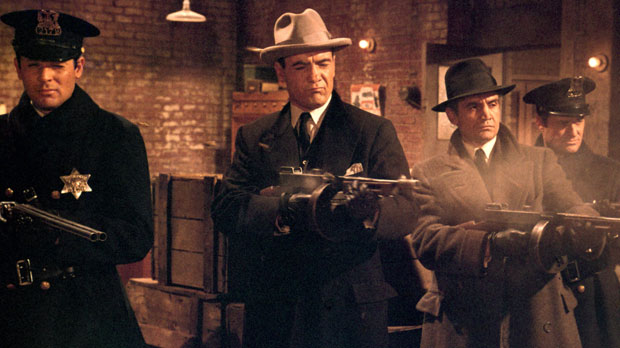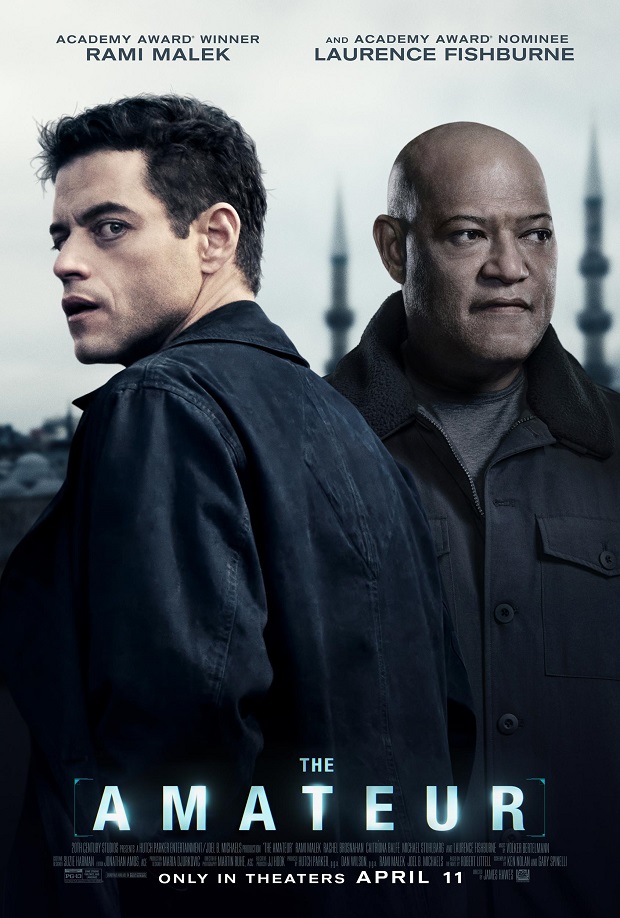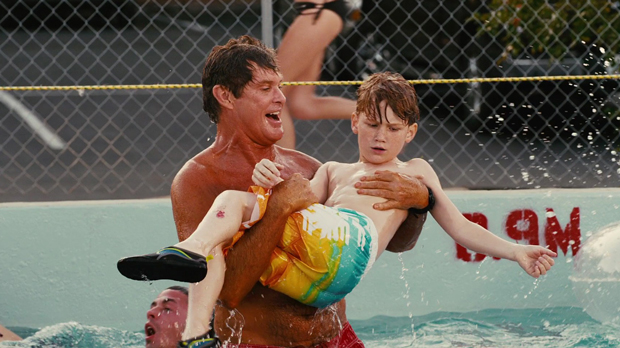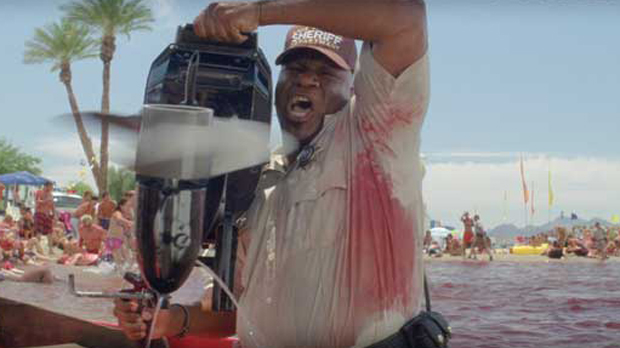 The St. Valentine’s Day Massacre (1967) 20th Century Fox/Drama-Action RT: 100 minutes No MPAA rating (strong violence, language) Director: Roger Corman Screenplay: Howard Browne Music: Lionel Newman and Fred Steiner Cinematography: Milton Krasner Release date: June 30, 1967 (US) Cast: Jason Robards, George Segal, Ralph Meeker, Jean Hale, Clint Ritchie, Frank Silvera, Joseph Campanella, Richard Bakalyan, David Canary, Bruce Dern, Harold J. Stone, Kurt Kreuger, Paul Richards, Joe Turkel, Milton Frome, John Agar, Mickey Deems, Celia Lovsky, Tom Reese, Jan Merlin, Alex D’Arcy, Reed Hadley, Gus Trikonis, Charles Dierkop, Tom Signorelli, Rico Cattani, Alex Rocco, Leo Gordon, Michele Guarini, Dick Miller, Jonathan Haze, Jack Nicholson, Paul Frees (narrator). Box Office: $1.7M (US)
The St. Valentine’s Day Massacre (1967) 20th Century Fox/Drama-Action RT: 100 minutes No MPAA rating (strong violence, language) Director: Roger Corman Screenplay: Howard Browne Music: Lionel Newman and Fred Steiner Cinematography: Milton Krasner Release date: June 30, 1967 (US) Cast: Jason Robards, George Segal, Ralph Meeker, Jean Hale, Clint Ritchie, Frank Silvera, Joseph Campanella, Richard Bakalyan, David Canary, Bruce Dern, Harold J. Stone, Kurt Kreuger, Paul Richards, Joe Turkel, Milton Frome, John Agar, Mickey Deems, Celia Lovsky, Tom Reese, Jan Merlin, Alex D’Arcy, Reed Hadley, Gus Trikonis, Charles Dierkop, Tom Signorelli, Rico Cattani, Alex Rocco, Leo Gordon, Michele Guarini, Dick Miller, Jonathan Haze, Jack Nicholson, Paul Frees (narrator). Box Office: $1.7M (US)
Rating: ** ½
Roger Corman, the director of the ambitious if not wholly effective historical crime drama The St. Valentine’s Day Massacre, originally wanted Orson Welles to play Chicago crime boss Al Capone, but Fox shot down the idea deeming the actor-filmmaker “undirectable”. Instead, Jason Robards (originally cast as Capone rival George “Bugs” Moran) got the part. I can’t say what the Citizen Kane actor would have done with the role, but Robards plays it to the hilt with a performance that often has him chewing away at the scenery. He’s pretty good, but I still prefer Robert De Niro’s Capone in The Untouchables.
Primarily known for low-budget pictures featuring bikers, women in prison and Vincent Price in Edgar Allan Poe adaptations, Corman made a rare venture into big studio filmmaking with The St. Valentine’s Day Massacre, a dramatization of the real-life mass murder of seven members of a rival gang by Capone’s men on the morning of February 14, 1929. It was the culmination of a territorial war between Capone and the Northside Gang led by Moran (Meeker, The Dirty Dozen) for control of Chicago’s bootlegging operations. In a bid to wrest control from Capone, Moran arranges for the murder of Mafia boss Patsy Lolardo (Guarini) in hopes that his successor will not protect his enemy. In turn, Capone has one his associates, “Machine Gun Jack” McGurn (Ritchie, Bandolero!), arrange the incident that will ultimately turn the tide of public opinion against gangsters and their illegal activities.
Corman presents The St. Valentine’s Day Massacre in the style of a docudrama with a narrator (an uncredited Paul Frees) introducing each character with a brief mini-bio- name, date of birth, position, list of offenses, date and manner of death, etc.- very much in the style of Welles. It’s an interesting idea, different from anything he ever did up to that point, but one that sometimes makes The St. Valentine’s Day Massacre feel more like a history lesson than entertainment. I almost felt like I should be taking notes in case there’s a test afterwards. It gets confusing with all the names, dates and data, a feeling that isn’t helped by a jumbled narrative that abruptly shifts into flashback mode with nary a warning to the viewer.
Sure, The St. Valentine’s Day Massacre has its structural weaknesses, but that doesn’t mean I don’t like it. Robards’ performance adds a nice element of camp, never mind that he doesn’t bear the slightest physical resemblance to Al Capone. He does manage to capture the kingpin’s volatile temper and propensity for violence sometimes even carrying out hits himself. That’s where it really counts, I suppose. Meeker is also good as Moran, a slippery sort who lucks out of being present at the garage when the massacre happens. George Segal, mainly known for comedies like The Owl and the Pussycat and A Touch of Class, shows his dark side as Moran henchman Peter Gusenberg, a vicious sort we first meet intimidating a speakeasy owner into switching over to their brand of illegal beer. A young Bruce Dern (Coming Home) has a small role as a driver/mechanic caught up in the slaughter. Corman regulars Jack Nicholson and Dick Miller show up in uncredited roles as a hood treating his bullets with garlic and a fake policeman respectively.
In terms of historical accuracy, The St. Valentine’s Day Massacre gets it mostly right. The only inaccuracy, made for dramatic purposes I’m sure, is the murder of Mafia turncoat Joe Aiello. He wasn’t killed until well after the St. Valentine’s Day massacre (October 23, 1930, to be exact). That being said, the scene where Capone confronts him on a train trying to leave town rings with suspense and dread. Other than that, Corman’s pretty much on the money. The violent finale- violent for 1967 just before the end of the Production Code, that is- was accomplished through use of crime photos taken at scene. Corman clearly did his homework.
The St. Valentine’s Day Massacre has some great scenes, one of the best being a flashback to an attempt on Capone’s life while he’s eating in a restaurant. He and his associates take cover on the floor while a parade a period-authentic cars drive by with tommy guns blazing away. Prohibition-era Chicago is stylishly recreated on backlot sets making it resemble a gangster movie from the 30s. The clothing, interiors and vehicles are all period authentic. The picture looks great especially when you consider that Corman brought it in under budget by about $400,000 (Fox gave him $2.5 million). For the most part, The St. Valentine’s Day Massacre is a decent gangster flick if you don’t let yourself get bogged down by personal and historical details.




